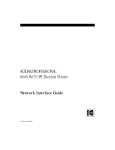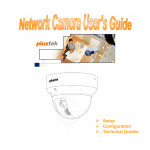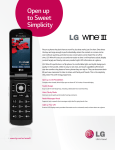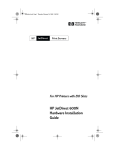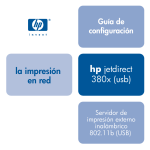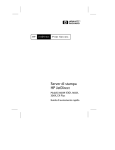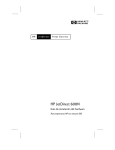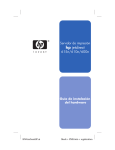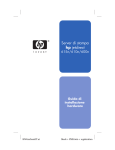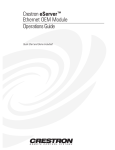Download HP ew2500 Setup and Install
Transcript
HP Jetdirect ew2500 802.11g Wireless Print Server Setup Guide HP Jetdirect ew2500 802.11g Wireless Print Server Setup Guide © 2004-2014 Copyright Hewlett-Packard Development Company, L.P. Reproduction, adaptation or translation without prior written permission is prohibited, except as allowed under the copyright laws. The information contained herein is subject to change without notice. The only warranties for HP products and services are set forth in the express warranty statements accompanying such products and services. Nothing herein should be construed as constituting an additional warranty. HP shall not be liable for technical or editorial errors or omissions contained herein. Applicable products: J8021A Edition 2, 11/2014 Microsoft®, MS-DOS®, Windows®, Microsoft Windows NT® are trademarks or U.S. registered trademarks of Microsoft Corporation. IBM®, AIX® are registered trademarks of International Business Machines Corp. Ethernet is a registered trademark of Xerox Corporation. PostScript® is a trademark of Adobe Systems, Incorporated. UNIX® is a registered trademark of the Open Group. Windows Vista™ is either a registered trademark or trademark of Microsoft Corporation in the United States and/or other countries. Table of contents 1 Introduction What's in the box .................................................................................................................................. 1 What you need to supply ...................................................................................................................... 2 Test button functions ............................................................................................................................ 3 Wireless LAN terms and concepts ...................................................................................................... 4 Access Point ........................................................................................................................ 4 Ad Hoc (peer-to-peer) mode ................................................................................................ 5 Channels .............................................................................................................................. 5 Encryption ............................................................................................................................ 6 Infrastructure mode .............................................................................................................. 6 Security type ........................................................................................................................ 7 Service Set Identifiers (SSID) .............................................................................................. 8 Signal range ......................................................................................................................... 8 Network printing terms and concepts .................................................................................................. 8 Client-server printing ............................................................................................................ 8 Peer-to-peer (direct mode) printing ...................................................................................... 9 Network protocols ................................................................................................................ 9 Network address .................................................................................................................. 9 Hardware address ............................................................................................................... 9 If you need help... ................................................................................................................................. 9 2 Install the print server hardware Set up the printer ................................................................................................................................ 11 If the printer is already set up ............................................................................................ 11 If the printer is not already set up ...................................................................................... 11 Connect the print server to the printer ............................................................................... 11 3 Make a network connection Configure a wireless network using the network (LAN) cable ............................................................ 13 Use a Microsoft Windows wireless PC .............................................................................. 14 Configure settings for a wired network ............................................................................................... 17 Use an Apple Macintosh wireless computer ...................................................................................... 18 Configure a wireless network without a network (LAN) cable ............................................................ 18 Factory-default wireless settings ....................................................................................... 20 ENWW iii Optional wireless connection setup methods ..................................................................................... 21 4 Install the printer on a network system or server Microsoft client-server networks ......................................................................................................... 26 5 Troubleshooting Reset the print server to factory defaults (“cold reset”) ...................................................................... 28 Interpret the status lights .................................................................................................................... 29 Unable to communicate with the print server (wireless) ..................................................................... 31 During initial setup ............................................................................................................. 31 After initial setup ................................................................................................................ 31 My configured channel does not match the configuration page ......................................................... 32 Improve reception and performance .................................................................................................. 32 Firmware download failure ................................................................................................................. 33 Appendix A Service and support Hewlett-Packard limited warranty statement ...................................................................................... 34 Your authorized dealer ...................................................................................................... 35 Service billing (out of warranty) ......................................................................................... 35 Service outside the USA .................................................................................................... 36 Local warranty statements ................................................................................................................. 36 Australia and New Zealand ................................................................................................ 36 Customer support ............................................................................................................................... 36 HP support online .............................................................................................................. 36 HP support by phone ......................................................................................................... 36 Product accessibility ........................................................................................................................... 36 Appendix B Solution summary HP support software ........................................................................................................................... 37 Embedded services ............................................................................................................................ 37 Supported network protocols .............................................................................................................. 38 Appendix C Specifications Electrical (power adapter) .................................................................................................................. 40 Environmental .................................................................................................................................... 41 Electromagnetic .................................................................................................................................. 41 Acoustic .............................................................................................................................................. 41 Radio characteristics .......................................................................................................................... 42 iv ENWW HP subassemblies ............................................................................................................. 42 Channel frequencies .......................................................................................................... 42 Safety ................................................................................................................................................. 42 Wireless telecommunications ............................................................................................................. 42 Appendix D Regulatory statements FCC statement ................................................................................................................................... 43 Regulatory Model Identification Number ............................................................................................ 44 Canada ............................................................................................................................................... 44 VCCI (Japan) ...................................................................................................................................... 44 RRL statement (Korea) ...................................................................................................................... 44 Regulatory wireless statements ......................................................................................................... 45 Exposure to radio frequency radiation ............................................................................... 45 Notice to users in Argentina ............................................................................................... 45 Notice to users in Brazil ..................................................................................................... 45 Notice to users in Canada ................................................................................................. 46 European Union regulatory notice ..................................................................................... 46 Notice to users in Indonesia .............................................................................................. 47 Notice to users in Korea .................................................................................................... 47 Notice to users in Mexico ................................................................................................... 47 Notice to users in Pakistan ................................................................................................ 47 Notice to users in Singapore .............................................................................................. 47 Notice to users in South Africa .......................................................................................... 47 Notice to users in Taiwan .................................................................................................. 48 ENWW v vi ENWW 1 Introduction Thank you for purchasing the HP Jetdirect ew2500 802.11g Wireless Print Server! This print server complies with IEEE 802.11g wireless standards. Use the HP Jetdirect ew2500 802.11g Wireless Print Server to directly connect your compatible HP printer to your network using either a wired or wireless connection. ● What's in the box ● What you need to supply ● Test button functions ● Wireless LAN terms and concepts ● Network printing terms and concepts ● If you need help... What's in the box ENWW 1 USB cable 2 Network (LAN) cable 3 External power adapter 4 HP Jetdirect ew2500 802.11g Wireless Print Server * Warranty card (where applicable) What's in the box 1 What you need to supply ● A supported Microsoft Windows or Apple Macintosh computer with the included Network (LAN) cable to configure wired and/or wireless settings. For a wireless network: an 802.11b or 802.11g wireless LAN (WLAN) interface card installed in the computer. NOTE: Use the included LAN cable to avoid possible radio interference problems during installation. After installation, you can remove the cable. ◦ Microsoft Windows XP, Vista, Server 2003, or Server 2008. ◦ Apple Mac OS X 10.2 and later. ◦ UNIX/Linux: Hewlett-Packard HP-UX, Sun Microsystems Solaris, IBM AIX, HP MPE-i, RedHat Linux, SuSE Linux If your network is entirely wireless, then a wireless computer is needed to set up a wireless connection from your printer to your network. ● For wireless infrastructure mode only: a wireless router, access point, or Apple base station. In infrastructure mode, an access point is a device that connects wireless devices, such as a wireless network printer, to your cabled network. See Wireless LAN terms and concepts on page 4 for more information. ● For Windows systems: the printer’s software driver for your Windows system. You can obtain your printer driver from one of the following sources: 2 ◦ printing system CD-ROM supplied with your printer ◦ HP support Web site at: www.hp.com/go/support. Chapter 1 Introduction ENWW Test button functions The test button, which is located on the back of the HP Jetdirect ew2500 print server, provides various functions depending on the number of the times the button is pressed. These functions can be useful during the installation process. NOTE: Typically, you press the button the indicated number of times in quick succession. However, some options provide additional functionality when holding the last button press. Table 1-1 Test button instructions Button Presses Function Instructions and Status Light (if applicable) 1 Print an HP Jetdirect configuration page. Changes to blinking green for approximately five seconds. 2 Print an HP Jetdirect security page. 3 Print an HP Jetdirect configuration page in English, French, Italian, German, or Spanish. 4 Print an HP Jetdirect wireless status page. 5 Change the LAN speed/handshake. This is only for switches that do not have auto negotiation mode set, Select from the following speeds/ handshake: 10 Mbps. half-duplex, 10 Mbps. full-duplex, 100 Mbps. halfduplex, or 100 Mbps. full-duplex. On the third press, hold the button down until the status light begins blinking, and then release the button. The configuration page prints in all languages. On the fifth press, hold the button down until the status light begins blinking, then release the button. Select from the following speed/handshake combinations (displayed three times): ● Blinking amber — 10 half-duplex ● Solid amber — 10 full-duplex ● Blinking green — 100 half-duplex ● Solid green — 100 full-duplex To select a speed/handshake: ENWW 1. Press and release the test button when the color associated with the speed/handshake you want is displayed. (The test button turns off then displays the selected color.) 2. If the speed is correct (indicated by the test button color), press and release the test button once to confirm. 3. If the speed/handshake is not correct (indicated by the test button color), do not press the test button. The change is not made. You can then start over and change the speed/ handshake. 4. To complete (save) the change, power cycle the print server. 6 Reset 802.1x to factory default values. To complete (save) the change, power cycle the print server. 7 Disable IPsec. To complete (save) the change, power cycle the print server. Test button functions 3 Wireless LAN terms and concepts Access Point An Access Point is a device that typically serves as a bridge or gateway between wireless devices and the devices on a cabled network. An Access Point must be able to receive and forward network traffic between wireless and cabled network devices. Multiple Access Points can act as repeaters to extend the range of a wireless network. Connecting via an access point is called Infrastructure Mode. On Apple networks, this is called Airport Network Mode. Figure 1-2 Access Point in enterprise workgroup Figure 1-3 Residential gateway as Access Point 4 Chapter 1 Introduction ENWW Figure 1-4 Access Point as wireless repeater Ad Hoc (peer-to-peer) mode Ad Hoc mode (or peer-to-peer mode) is a wireless network topology where wireless devices communicate with each other directly. An Access Point is not used. On Apple networks, Ad Hoc mode is called computer-to-computer mode. NOTE: Ad Hoc mode is not as reliable as Infrastructure mode, and if used, should be limited to six devices or less. When set in this mode, the HP Jetdirect print server receives print jobs from wireless computers directly. Figure 1-5 Ad Hoc mode: a peer-to-peer wireless network topology NOTE: The term “peer-to-peer” might have a different meaning depending on its usage. While Ad Hoc peer-to-peer mode refers to a wireless network topology, HP Jetdirect peer-to-peer printing refers to a direct print path from a network computer to a printer. HP Jetdirect peer-to-peer printing can be used on both Ad Hoc or Infrastructure wireless topologies. Channels IEEE standards for 802.11b and 802.11g wireless LANs specify a spectrum of radio waves for wireless communications. The allowed spectrum is divided into channels consisting of 22 MHz each. The number ENWW Wireless LAN terms and concepts 5 of available channels authorized for use may be restricted based on your location (see Radio characteristics on page 42). ● If the print server is powered on and discovers a wireless network whose SSID (network name) is also “hpsetup”, it will automatically adjust its channel to match that network. ● If the print server is reconfigured for Infrastructure mode, it will automatically adjust its channel to match the Access Point. Encryption Wireless networks use radio signals for network communications, which can be easily monitored by someone eavesdropping on the network. To deter eavesdropping and to help ensure data privacy, encryption of wireless communications may be used. For HP Jetdirect print servers in their factory-default state, encryption of wireless communications is disabled. However, the print servers support static WEP and popular dynamic encryption protocols. NOTE: Wireless performance may be reduced when using encryption keys due to the additional processing time required. Static Encryption. WEP encryption protocols were developed to provide a basic level of data privacy. WEP protocols use static encryption keys to encrypt and decrypt wireless communications. NOTE: WEP encryption levels are sometimes called 40-bit, 64-bit, 104-bit, or 128-bit encryption. Both 40-bit and 64-bit encryption are really the same, as are 104-bit and 128-bit encryption. When entering WEP keys, the user specifies 40 bits for 64-bit encryption, or 104 bits for 128-bit encryption. An additional 24 initialization vector (IV) bits are automatically added for a total of 64 bits and 128 bits, respectively. In this guide, we will use “40/64-bit” and “104/128bit” to specify these WEP encryption levels. For basic encryption, static WEP keys are configured on each device on the wireless network. WEP keys are considered static because they remain the same unless manually reconfigured. For example, on a typical Infrastructure mode network that uses static WEP encryption, a change to the WEP key on an Access Point will require a manual change to the WEP key on each wireless device. HP Jetdirect wireless print servers support configuration of up to four static WEP keys, for either 40/64bit or 104/128-bit encryption. Dynamic Encryption. For advanced encryption methods, dynamic encryption protocols are used. For dynamic encryption protocols, encryption keys are automatically changed at routine intervals making them difficult to decipher. Dynamic encryption protocols, such as dynamic WEP and wi-fi protected access (WPA/WPA2), provide a more secure wireless environment. When configured for WPA/WPA2–Personal authentication, HP Jetdirect print servers use WPA encryption. Infrastructure mode Infrastructure mode is a wireless network topology where all wireless communications go through an Access Point. Infrastructure mode is called a Basic Service Set (BSS), and sometimes referred to as “enterprise mode.” On Apple networks, Infrastructure mode is called Airport Network mode. When set 6 Chapter 1 Introduction ENWW in this mode, the HP Jetdirect print server receives print jobs from wireless and cabled network computers through an Access Point. Figure 1-6 Infrastructure mode: a wireless topology that uses an Access Point for connection to a wired network Security type Security is used to validate the identification of each device or computer that is attempting to access a network. The security type used on a network is determined during network design and depends on the network security requirements. Consequently, security methods are closely associated with encryption options that are also used on the network. HP Jetdirect wireless print servers support the following security types: ENWW ● No security. No encryption or authentication is used. Open system. Your wireless network does not require device authentication or security to access the network. However, your network might use WEP encryption keys for data privacy. ● WEP-Personal. Each device on your wireless network uses a shared encryption key (a shared password value) for network access and communication. Each device on the network must use the same key. The HP Jetdirect print server supports IEEE 802.11 WEP keys for encrypted network communications. ● WEP-Enterprise. The network uses WEP with EAP/802.1x authentication. This type of security utilizes a central authentication server, such as RADIUS, to authenticate users on the network. The HP Jetdirect print server supports these server-based authentication protocols: LEAP, PEAP, and EAP-TLS. ● WPA/WPA2–Personal. Your network uses wi-fi protected access (WPA) with a pre-shared key that is typically generated by a pass-phrase. WPA encryption is normally used for wireless communication and offers improved security. ● WPA/WPA2–Enterprise. Your network uses WPA with EAP/802.1x authentication. This type of security utilizes a central authentication server, such as RADIUS, to authenticate users on the network. The HP Jetdirect print server supports these server-based authentication protocols: LEAP, PEAP, and EAP-TLS. Wireless LAN terms and concepts 7 Service Set Identifiers (SSID) An SSID is a logical name assigned to a wireless LAN. It is typically used to provide LAN access control. For example, if the SSID for a wireless network is “mycompany”, then each wireless device on this network must be configured with this SSID. In infrastructure mode, the Access Point will require wireless devices to be configured with the appropriate SSID before network access is allowed. Signal range The range over which wireless devices can communicate depends on the physical environment and the orientation of the HP Jetdirect print server. For 802.11g, the range is typically 50 feet at the highest data rate (54 Mbps). Data rate will decrease to 802.11b levels as range, traffic and interference increase. For 802.11b, the range is typically 100 feet at the highest data rate (11 Mbps), and 300 feet at the lowest data rate (1 Mbps). In general, while radio waves can bounce off obstacles to access print servers, it is best to have clear line-of-sight access between devices without obstacles through which the signal must pass. NOTE: Signal range and wireless transmission performance is reduced with increasing distance between devices, and with obstacles that block or absorb signals. Network printing terms and concepts Client-server printing On a client-server network, client computers send print jobs to a dedicated network server that controls the use of each installed printer. The HP Jetdirect print server receives print jobs over the network under the network server’s control, or can automatically monitor print queues and de-spool print jobs from the network server. Figure 1-7 Client-server printing (in Infrastructure mode) 8 Chapter 1 Introduction ENWW Peer-to-peer (direct mode) printing On a peer-to-peer network, dedicated network servers are not used. Instead, an HP Jetdirect-connected network printer is installed on each client computer that will send print jobs directly to the printer. Figure 1-8 Peer-to-peer printing Network protocols For network computers and printers to communicate on a network, they must use a common language, or network protocol. The HP Jetdirect print server can support many different network protocols simultaneously, such as TCP/IP (Transmission Control Protocol/Internet Protocol) and IPX (Internet Packet Exchange). For a list of supported protocols, see Supported network protocols on page 38. TCP/IP is the most commonly used protocol in most network environments. Network address Each device on a network must be identified by a unique network address for the specific network protocol used. On an IPX network, the network address is assigned automatically. On an IP network, configuration and assignment of IP addresses and other IP settings are a bit more complex. Network addresses are configured and stored on each HP Jetdirect print server during installation, and are listed on the HP Jetdirect configuration page for the print server. Hardware address Each device on a network contains a unique LAN hardware (or “station”) address that is assigned by the manufacturer of the device. Because the HP Jetdirect print server connects printers to a network, each print server contains a LAN hardware address assigned by Hewlett-Packard. The address consists of 12 hexadecimal digits (0 through F). The first 6 digits uniquely identify the manufacturer, and the second 6 digits uniquely identify the device. The LAN hardware address is important because it may be needed to identify the printer during installation. It is listed on the HP Jetdirect configuration page for each print server. In addition, it is listed on a label attached to the print server. If you need help... Go to http://www.hp.com/support/net_printing and select your JetDirect model for more information. ENWW If you need help... 9 10 Chapter 1 Introduction ENWW 2 Install the print server hardware Set up the printer NOTE: Do not install any printer software until all of the hardware connection steps have been completed. If the printer is already set up 1. Turn off the printer. 2. Detach it from any computer. 3. Turn on the printer. 4. Proceed to Connect the print server to the printer on page 11. If the printer is not already set up 1. Assemble the hardware only using the instructions supplied with the printer. 2. Set aside the printer CD. (Do not install its software yet. Do not attach the printer to your computer.) 3. Turn on the printer. 4. Print a test page as instructed. Connect the print server to the printer 1. Connect the USB cable. ● Plug the supplied USB cable into the USB connector on the back of the print server. ● Plug the other end of the cable into the printer’s USB connector. CAUTION: Do not use a USB hub, extender or parallel converter. ENWW Set up the printer 11 2. 12 Connect the power cable. ● Plug the supplied power module into a power outlet. ● Plug the other end of the power cable into the power connector on the back of the print server. 3. Print a configuration page by pressing the test button once. (The test button is located on the back of the HP Jetdirect ew2500 print server.) 4. Proceed to Make a network connection on page 13. Chapter 2 Install the print server hardware ENWW 3 Make a network connection This section describes how to configure the HP Jetdirect ew2500 802.11g Wireless Print Server with either a wired or wireless network connection to your network. NOTE: You can use a wired network connection to configure either wired or wireless settings. HP recommends that you use a wired connection to configure wireless settings. Configuration procedures: ● To configure wireless settings using the included network (LAN) cable, go to Configure a wireless network using the network (LAN) cable on page 13. ● To configure settings for a wired network, go to Configure settings for a wired network on page 17. ● To configure settings for an Apple Macintosh wireless computer, go to Use an Apple Macintosh wireless computer on page 18. ● To configure wireless settings without a network (LAN) cable, go to Configure a wireless network without a network (LAN) cable on page 18. ● For optional methods, go to Optional wireless connection setup methods on page 21. Configure a wireless network using the network (LAN) cable For wireless operation, the print server needs to be connected to your wireless network before you can discover and install the printer on your PC or other network system. You can configure the wireless settings with the included network (LAN) cable, which can be removed after you have completed configuring the wireless settings. NOTE: HP recommends that you configure the wireless settings using a network (LAN) cable (wired). Although you can configure without a network cable (wireless), it is generally easier to configure using the included network (LAN) cable. After connecting the cable, allow up to 30 seconds for the cable connection to be enabled. When disconnecting the cable after configuration, allow up to 30 seconds for the wireless connection to enable automatically. ENWW Configure a wireless network using the network (LAN) cable 13 To configure a wireless connection using a network (LAN) cable, verify the following: ● You have a computer with one of the following operating systems: ◦ Microsoft Windows XP, Vista, Server 2003, or Server 2008. ◦ Apple Mac OS X 10.2 or greater. ● You have installed the HP Jetdirect print server hardware and have printed an HP Jetdirect configuration page. ● (Infrastructure mode only) The wireless router, access point, or Apple base station on your network is operating properly. CAUTION: If you reset the print server to factory-default values after you configure a wireless network connection, the network connection will be lost. To reestablish a connection, you must reconfigure the print server. 14 Chapter 3 Make a network connection ENWW ENWW Configure a wireless network using the network (LAN) cable 15 16 Chapter 3 Make a network connection ENWW Configure settings for a wired network A network connection is required before you can discover and install the printer on your network systems. To configure a wired connection, verify the following: ● ● ENWW You have a computer with one of the following operating systems: ◦ Microsoft Windows XP, Vista, Server 2003, or Server 2008. ◦ Apple Mac OS X 10.2 or greater. You have installed the HP Jetdirect print server hardware and have printed an HP Jetdirect configuration page. Configure settings for a wired network 17 Set up each Windows computer for printing on the networked printer by inserting the CD-ROM and selecting Install. This basic procedure involves configuring network parameters for the print server, installing printer drivers and other software, and setting up the print path. To use the wizard to install the networked printer on this computer, return to the initial screen for this CD, select Install, and follow the instructions. Help is included. When finished there, this computer is ready to use the printer. NOTE: Making network address changes might break the print path set up by the wizard if the printer has been previously installed on the computer. 18 Chapter 3 Make a network connection ENWW ENWW Configure a wireless network without a network (LAN) cable 19 Factory-default wireless settings The HP Jetdirect print server wireless factory-default settings are shown in the following table. 20 Chapter 3 Make a network connection ENWW Table 3-1 Factory default wireless settings Parameter Settings Comments Communications Mode Ad Hoc If your network uses a wireless router, access point, or Apple base station, reconfigure the Communications Mode of the HP Jetdirect print server to Infrastructure. Channel 11 (Ad Hoc mode only) Specifies the broadcast channel if the print server fails to connect to a network. In most cases, you will not need to change this setting. The print server scans all available channels for the specified network and adapts its channel to the one detected. Network Name (SSID) hpsetup Change the SSID on the print server to match your network. The SSID is case sensitive. Authentication Open System The HP Jetdirect print server is not configured for network authentication. If required by your network, the proper authentication method must be configured on the HP Jetdirect print server. Encryption (WEP) [Disabled] If your network uses WEP encryption keys, configure the encryption keys on the print server. You can configure up to four WEP keys. The active key must match the value and active key position (for example, Key 1) configured on other wireless devices. Optional wireless connection setup methods To use Telnet or the HP embedded Web server, first reconfigure your wireless computer to communicate using the HP Jetdirect factory-default settings, and then create an IP path to the default IP address (check the HP Jetdirect configuration page for the IP address assigned on the print server). To create an IP path, use one of the following methods: ENWW ● If supported, use a “route add” command from your system prompt (see your system help or documentation). ● Temporarily reconfigure your computer’s IP address to match the default IP network of the HP Jetdirect print server. For example, if the print server IP address is 169.254.111.111, you could use 169.254.111.112 for your computer. Before modifying your computer’s settings, you should record your current settings, or if possible, create a new profile for your temporary settings. Optional wireless connection setup methods 21 Optional methods to configure a wireless network connection include: 22 ● Using a Telnet session with the HP Jetdirect print server to configure selected wireless parameters (not all wireless parameters can be set through Telnet). For information on available Telnet commands, use the Telnet help command. ● Using your Web browser to access the HP embedded Web server on the HP Jetdirect wireless print server. Chapter 3 Make a network connection ENWW 4 Install the printer on a network system or server Once your printer is connected to your network (wired or wireless), you can install the printer on the dedicated print server. ● ENWW Microsoft client-server networks Before you begin... 23 24 Chapter 4 Install the printer on a network system or server ENWW ENWW Microsoft networks 25 Microsoft client-server networks After you have set up the printer on the server, set up your network clients to access the printer through the server. The procedures depend on the utilities available for your particular clients and network operating system. For example, if the printer is installed and shared on a Microsoft server, each Windows client can use Add Printer or Network Neighborhood utilities to access the printer. For more information, refer to the documentation and help supplied with your network operating system. 26 Chapter 4 Install the printer on a network system or server ENWW ENWW To view documents on the CD-ROM 27 5 Troubleshooting This section provides basic troubleshooting information. ● Reset the print server to factory defaults (“cold reset”) ● Interpret the status lights ● Unable to communicate with the print server (wireless) ● My configured channel does not match the configuration page ● Improve reception and performance ● Firmware download failure To troubleshoot your HP Jetdirect print server, you may need the following items: ● An HP Jetdirect Configuration Page ● A Printer Configuration or Diagnostic Page ● Documentation that came with your printer ● The diagnostics tools and utilities provided with your network software (for example, TCP/IP utilities, or network printer management applications such as HP Web Jetadmin) NOTE: Frequently asked questions about installing and configuring the HP Jetdirect print server can be found by searching for your HP Jetdirect product at: www.hp.com/support/net_printing. Reset the print server to factory defaults (“cold reset”) Once you have configured the HP Jetdirect print server, your settings are saved in memory even over power cycles. If you lose communications with the HP Jetdirect print server, or it fails to operate properly, you might need to reset the print server to its factory-default configuration. This is called a cold reset. 28 Chapter 5 Troubleshooting ENWW CAUTION: Resetting the HP Jetdirect wireless print server to factory-default settings can cause the print server to lose its wireless connection to your network. Reconfiguration of wireless network settings and reinstallation of the print server might be required. If a printer reset is required, settings are reset to their factory default values. If you reset the printer, you might need to reconfigure the printer’s settings that are required by users. To restore factory-default settings on an HP Jetdirect ew2500 print server, follow these steps: 1. Unplug the power module from the back of the print server. 2. While holding down the test button on the back of the print server, plug the power module back into the print server then release the test button. Any user-configured settings will be erased. When you restore the print server to its factory-default settings, you should print an HP Jetdirect configuration page to confirm that factory-default values have been assigned. Interpret the status lights The HP Jetdirect ew2500 status lights provide information about the USB, wired, and wireless connections. The Link and Act status lights on the LAN connector indicate network activity. ENWW 1 USB 2 Wired 3 Wireless 4 Link (on LAN connector) 5 Act (on LAN connector) Interpret the status lights 29 Table 5-1 HP Jetdirect ew2500 802.11g Wireless Print Server status lights Light State Color Description USB Solid Green USB cable connected, fully operational. Off — USB cable not connected, not operational. Solid Yellow Error condition. Blinking Green Software attention. Yellow Hardware attention. — ● Initializing. ● Being used in a wireless configuration. ● Power is off. Wired Wireless Off Solid Green Link exists, good signal strength. Flickering Green Network activity, good signal strength. Blinking (fast) Green Test Button pressed, good signal. Off — ● Initializing. ● Being used in a wired configuration. ● Power is off. Blinking (slow) Blue Running a self test, scanning, or there is no link. Solid Blue Wireless link exists, good signal strength. Amber Wireless link exists, weak signal strength. Blue Network activity, good signal strength. Amber Network activity, weak signal strength. Blue Test Button pressed, good signal. Amber Test Button pressed, weak signal. Solid Green Successfully linked to the network. Off — No link. Solid Yellow Network transmission activity. Off — No activity. Flickering Blinking (fast) Link Act 30 Chapter 5 Troubleshooting ENWW Unable to communicate with the print server (wireless) During initial setup Verify the following: ● Your wireless computer is configured to match the default wireless network settings on the HP Jetdirect print server: ◦ Communication Mode: Ad Hoc ◦ Network Name (SSID): hpsetup ◦ Encryption (WEP): [Disabled] NOTE: The Network Name (SSID) is case-sensitive. If the configuration settings are incorrect, connecting to the network might fail. If the connection fails after entering configuration settings, reset the print server to factory-default settings (“cold reset”) and try again. ● The HP Jetdirect print server is turned on and operating properly (print an HP Jetdirect configuration page). ● You are within range of the HP Jetdirect print server. ● There are fewer than six devices total on the Ad Hoc network (with SSID “hpsetup”). ● There is no Access Point in the vicinity that is configured with an SSID of “hpsetup.” ● (For Telnet or HP embedded Web server access) Multiple print servers are not being configured at the same time. If there are, turn all off except the one you want to configure. After initial setup If you have successfully configured the HP Jetdirect wireless print server with a network connection to your network, but your network computers are unable to communicate with the printer (including a “ping” command), try the following: ● ENWW Print an HP Jetdirect configuration page and verify all configuration settings for your network. Common errors include incorrect entries for the following items: ◦ Communication Mode (Ad Hoc or Infrastructure) ◦ Network Name (SSID), which is case-sensitive ◦ Authentication method ◦ Encryption level, encryption key entries, or the specified transmit key Unable to communicate with the print server (wireless) 31 ◦ IP address ◦ BSSID (Basic Service Set Identifier), which distinguishes one wireless LAN from another even though they have the same SSID. ● Verify that the printer is within range of the network. See Improve reception and performance on page 32 for more information. ● Use a wireless PC and its utilities to confirm the signal strength at the printer’s location. The detected signal strength should be similar for the print server, as indicated on the HP Jetdirect configuration page. My configured channel does not match the configuration page (Ad Hoc mode only) The HP configuration tools allow you to select channel 10 (default) or 11 on the HP Jetdirect wireless print server. This channel is only used by the print server to broadcast its Network Name (SSID) if it fails to detect and join an existing wireless network. If it is able to join a network, it will reconfigure its channel to the one used by the network. The HP Jetdirect configuration page will identify the network channel actually being used on a network. It does not show the broadcast channel used when a network is not detected. Improve reception and performance Wireless LAN radio signals can penetrate many indoor structures and can reflect around obstacles. However, wireless communication range and performance depends on a variety of factors, including the number of users, the quality and physical placement of the wireless hardware, and the sources of radio signal interference (for example, microwave ovens and cordless telephones use similar frequencies that may interfere with wireless LAN signals). In general, the HP Jetdirect wireless print server data transfer rates will decrease with increasing distance, obstructions and interference. For these symptoms 32 ● Wireless status light is amber. ● The signal strength is poor or marginal. ● Print jobs are excessively slow. Chapter 5 Troubleshooting ENWW Try these actions ● Reorient the HP Jetdirect print server's location in relation to the Access Point or wireless PC. This might improve reception and performance. ● Reduce or remove sources of interference. Metallic objects can absorb or attenuate radio signals, and devices such as microwave ovens and cordless phones operate using similar radio frequencies. ● Reduce the distance between the printer and the Access Point or wireless PC. This can be accomplished by: ● ◦ moving the print server ◦ moving the Access Point or wireless PC ◦ adding an additional Access Point (Infrastructure mode only) Elevate the Access Point’s antenna. In most office environments, elevating the Access Point’s antenna will improve the range and performance of all wireless devices. Firmware download failure The HP Jetdirect ew2500 print server provides limited firmware upgrade capabilities. As with other HP Jetdirect print servers, firmware upgrades may be downloaded as available using tools such as HP Download Manager (Windows), HP Web Jetadmin, HP embedded Web server, or FTP (File Transfer Protocol). If the firmware download fails to complete, you should restart the download without cycling power to the print server. If power is lost during the download and the print server must be restarted, your next steps depend on whether the print server is configured for server-based authentication. ENWW Firmware download failure 33 A Service and support ● Hewlett-Packard limited warranty statement ● Local warranty statements ● Customer support ● Product accessibility Hewlett-Packard limited warranty statement HP product Duration of limited warranty HP Jetdirect ew2500 print server 1 Year HP warrants to you, the end-user customer, that HP hardware and accessories will be free from defects in materials and workmanship after the date of purchase, for the period specified above. If HP receives notice of such defects during the warranty period, HP will, at its option, either repair or replace products which prove to be defective. Replacement products may be either new or equivalent in performance to new. HP warrants to you that HP software will not fail to execute its programming instructions after the date of purchase, for the period specified above, due to defects in material and workmanship when properly installed and used. If HP receives notice of such defects during the warranty period, HP will replace software which does not execute its programming instructions due to such defects. HP does not warrant that the operation of HP products will be uninterrupted or error free. If HP is unable, within a reasonable time, to repair or replace any product to a condition as warranted, you will be entitled to a refund of the purchase price upon prompt return of the product. HP products may contain remanufactured parts equivalent to new in performance or may have been subject to incidental use. Warranty does not apply to defects resulting from (a) improper or inadequate maintenance or calibration, (b) software, interfacing, parts or supplies not supplied by HP, (c) unauthorized modification or misuse, (d) operation outside of the published environmental specifications for the product, or (e) improper site preparation or maintenance. TO THE EXTENT ALLOWED BY LOCAL LAW, THE ABOVE WARRANTIES ARE EXCLUSIVE AND NO OTHER WARRANTY OR CONDITION, WHETHER WRITTEN OR ORAL, IS EXPRESSED OR IMPLIED AND HP SPECIFICALLY DISCLAIMS ANY IMPLIED WARRANTIES OR CONDITIONS OF 34 Appendix A Service and support ENWW MERCHANTABILITY, SATISFACTORY QUALITY, AND FITNESS FOR A PARTICULAR PURPOSE. Some countries/regions, states or provinces do not allow limitations on the duration of an implied warranty, so the above limitation or exclusion might not apply to you. This warranty gives you specific legal rights and you might also have other rights that vary from country/region to country/region, state to state, or province to province. HP's limited warranty is valid in any country/region or locality where HP has a support presence for this product and where HP has marketed this product. The level of warranty service you receive may vary according to local standards. HP will not alter form, fit or function of the product to make it operate in a country/region for which it was never intended to function for legal or regulatory reasons. TO THE EXTENT ALLOWED BY LOCAL LAW, THE REMEDIES IN THIS WARRANTY STATEMENT ARE YOUR SOLE AND EXCLUSIVE REMEDIES. EXCEPT AS INDICATED ABOVE, IN NO EVENT WILL HP OR ITS SUPPLIERS BE LIABLE FOR LOSS OF DATA OR FOR DIRECT, SPECIAL, INCIDENTAL, CONSEQUENTIAL (INCLUDING LOST PROFIT OR DATA), OR OTHER DAMAGE, WHETHER BASED IN CONTRACT, TORT, OR OTHERWISE. Some countries/regions, states or provinces do not allow the exclusion or limitation of incidental or consequential damages, so the above limitation or exclusion may not apply to you. THE WARRANTY TERMS CONTAINED IN THIS STATEMENT, EXCEPT TO THE EXTENT LAWFULLY PERMITTED, DO NOT EXCLUDE, RESTRICT OR MODIFY AND ARE IN ADDITION TO THE MANDATORY STATUTORY RIGHTS APPLICABLE TO THE SALE OF THIS PRODUCT TO YOU. Your authorized dealer If you encounter difficulty, begin by contacting the person who sold you the HP Jetdirect print server to you. Your HP authorized dealer will be familiar with your requirements and can provide assistance. During the warranty period, HP will replace the unit at no charge provided the defective unit is returned. You may return the unit to your HP authorized dealer or your local HP sales and service office representative. Be sure to include a copy of your purchase receipt. For warranty service on HP Jetdirect products, call HP support. When calling, please have the following information ready: ● HP Jetdirect product you are calling about. ● Model number of the product. ● Serial number of the product. ● Complete description of the problem. ● Proof of purchase of your product. ● Your shipping address. The HP support representative will help you with troubleshooting, and advise you on warranty service. Service billing (out of warranty) When ordering a replacement unit for out-of-warranty service, you may be charged a repair cost. See your HP authorized dealer or your local HP sales and service office representative. Or, you can call HP at (800) 227-8164 (USA only). ENWW Hewlett-Packard limited warranty statement 35 Service outside the USA Customers outside the USA should contact their HP authorized dealer or HP sales and service office to obtain information on prices, exchange unit availability and instructions. Local warranty statements Australia and New Zealand For consumer transactions in Australia and New Zealand: The warranty terms contained herein except to the extent lawfully permitted, do not exclude, restrict, or modify and are in addition to the mandatory statutory rights applicable to the sale of this product to you. Customer support For warranty information, see Hewlett-Packard limited warranty statement on page 34. HP support online Click your way to a quick solution! The HP Web site at www.hp.com/support/net_printing is a great place to start for information about your HP Jetdirect print server – 24 hours a day, 7 days a week. For the latest HP Jetdirect installation software and documentation, visit www.hp.com/go/inpw_sw. For the latest firmware for your HP Jetdirect print server, visit www.hp.com/go/webjetadmin_firmware. HP support by phone Highly trained technicians are ready to take your call. For toll-free phone support in the USA and Canada, call HP support at: 1-800-HPINVENT (1-800-474-6836) For the most recent HP support telephone numbers and available services worldwide, visit www.hp.com/ support. NOTE: The phone numbers listed may not be toll-free. Telephone fees are the responsibility of the caller. Rates may vary. Contact your local telephone company for current rates. Product accessibility For information on our commitment to accessibility of HP Jetdirect print server products: 36 ● Visit the HP Web site at www.hp.com/accessibility. ● Send an email message to: [email protected]. Appendix A Service and support ENWW B Solution summary ● HP support software ● Embedded services ● Supported network protocols HP support software Table B-1 HP support software ● HP Web Jetadmin software (TCP/IP and IPX networks) ● HP embedded Web server ● HP network printing setup software ◦ HP LaserJet Utility for Macintosh (Mac OS) Embedded services Key services embedded in the HP Jetdirect ew2500 print server are listed below. For the latest features and services, visit www.hp.com/go/jetdirect. Table B-2 Embedded services ● ENWW Configuration and management ◦ BootP/DHCP (IPv4 only) ◦ DHCPv6 ◦ TFTP (IPv4 only) ◦ Web Proxy (Automatic/Manual cURL) ◦ LLMNR ◦ Telnet (IPv4 only) ◦ SNMP (v1, v2c, v3) agents ◦ Bonjour (for Mac OS X) ◦ FTP (File Transfer Protocol) ◦ WS Discovery (Microsoft Web Services) HP support software 37 ● ● ● ◦ HP embedded Web server, HTTP (TCP port 80) ◦ HP embedded Web server, HTTPS (TCP port 443) ◦ IP Security (IPsec) ◦ Fleet configuration Printing ◦ Raw IP printing (HP-proprietary TCP ports 9100, 9101, 9102) ◦ LPD printing (TCP port 515) ◦ IPP printing (TCP port 631) ◦ FTP printing (TCP ports 20, 21) ◦ WS Print (Microsoft Web Services) Security ◦ SNMP v3 ◦ SSL/TLS ◦ 802,1X authentication: WEP, WPA, WPA2, LEAP, PEAP, and EAP-TLS ◦ Firewall Supported Web browsers (for HP embedded Web server) ◦ Microsoft Internet Explorer 6.x and higher ◦ Firefox 2.x and higher ◦ Opera 9.0 and higher ◦ Safari 2.0 and higher Supported network protocols The supported network protocols, and popular network printing environments that use those protocols, are listed below. Table B-3 Supported network protocols Supported network protocols Typical network printing environments1 TCP/IPv4 (Direct Mode printing) Microsoft Windows XP (32-bit and 64-bit), Vista (64-bit), Server 2003 (32-bit and 64-bit), and Server 2008 (32-bit and 64-bit) Microsoft Terminal Server and Citrix MetaFrame environments2 Novell NetWare2 5, 6.x Mac OS 10.2 and later UNIX and Linux, including: Hewlett-Packard HP-UX 10.2, 11.x, 11.i, Sun Microsystems Solaris 2.5 and later (SPARCsystems only), IBM AIX 3.2.5 and later2, HP MPE-iX2, RedHat Linux 7.x and later2, SuSE Linux 8.x and later2 LPR/LPD (Line Printer Daemon, RFC 1179–compliant) systems2 38 Appendix B Solution summary ENWW Table B-3 Supported network protocols (continued) Supported network protocols Typical network printing environments1 IPP (Internet Printing Protocol) FTP (File Transfer Protocol) printing TCP/IPv6 Microsoft Windows XP (32-bit and 64-bit), Vista (64-bit), Server 2003 (32-bit and 64-bit), and Server 2008 (32-bit and 64-bit), Direct Mode port 9100 printing (Requires HP IPv6/IPv4 port monitor software running on the system.) Mac OS 10.2 and later LPR/LPD (Line Printer Daemon, RFC 1179–compliant) systems with IPv6 client support IPP (Internet Printing Protocol) systems with IPv6 client support FTP (File Transfer Protocol) printing IPX/SPX and compatible Novell NetWare 5, 6.x2 Microsoft Windows XP (32-bit only), Direct Mode printing 1 Other protocols Novell NetWare NDS, Bindery, NDPS, and iPrint DLC/LLC DLC/LLC protocols are provided for legacy systems that may require support2 AppleTalk Mac OS Refer to the current HP Jetdirect product data sheets for additional network systems and versions. For operation with other network environments, consult your system vendor or authorized HP dealer. 2 ENWW Contact your network system vendor for software, documentation, and support. Supported network protocols 39 C Specifications ● Electrical (power adapter) ● Environmental ● Electromagnetic ● Acoustic ● Radio characteristics ● Safety ● Wireless telecommunications Electrical (power adapter) The following lists the power adapters for the HP Jetdirect ew2500 print server. Power Adapters for J8021A 40 Location Power Adapter* Power Cord Assembly** USA and Canada, Latin America 120 Vac (except as noted below) 0957-2228 None 0957-2229 8121-1023 Latin America 100-240 Vac (except as noted below), Continental Europe (except as noted below), South Korea 0957-2229 8121-1015 Denmark 0957-2229 8121-1011 Chile 0957-2229 8121-1012 India 0957-2229 8121-1013 Brazil 0957-2229 8121-1014 Australia and New Zealand 0957-2229 8121-1016 United Kingdom, Ireland, Hong Kong SAR, Singapore 0957-2229 8121-1017 Japan 0957-2229 8121-1018 China 0957-2229 8121-1019 Taiwan 0957-2229 8121-1020 Argentina 0957-2229 8121-1021 Appendix C Specifications ENWW Power Adapters for J8021A Location Power Adapter* Power Cord Assembly** Switzerland 0957-2229 8121-1022 South Africa 0957-2229 8121-1028 Israel 0957-2229 8121-1032 Malaysia 0957-2229 8121-1017 * 0957-2228 Power adapter, AC-DC, 15W, USA wall adapter. 0957-2229 and 0957-2234 power adapter, AC-DC, 15W, Universal In-Line adapter. ** 3-conductor, 0.5 meter power cords. For optional power cord lengths, contact HP Support. Environmental Operating Non-Operating 0° to 55° C -40° to 70° C (32° to 131° F) (-40° to 158° F) Relative humidity (noncondensing) 15% to 95% at 40° C (104° F) 15% to 95% at 65° C (149° F) Maximum altitude 4.6 km (15,000 ft) 4.6 km (15,000 ft) Temperature Electromagnetic ● FCC Title 47 CFR Part 15 Class B for Ethernet (USA) ● ICES-003 Class B (Canada) ● VCCI Class B (Japan) ● AS/NZS3548 Class B (Australia, New Zealand) ● CISPR-22 Class B (1997)* (International, Europe) ● CNS 13438 Class B (Taiwan) ● Korean EMI Law, No. 1996-98 Class B (Korea) Acoustic Not applicable. ENWW Environmental 41 Radio characteristics HP subassemblies The HP Jetdirect ew2500 print server is designed for operation with radio frequencies in the licensefree 2.4 GHz band. However, due to local radio regulations and restrictions, the radio characteristics of your particular HP Jetdirect print server can vary according to the location in which the product is used. Channel frequencies The channel frequencies are listed below: Channel Frequency (MHz) Channel Frequency (MHz) 1 2412 8 2447 2 2417 9 2452 3 2422 10 2457 4 2427 11 2462 5 2432 12 2467 6 2437 13 2472 7 2442 14 (Japan only) 2484 Safety Product complies with: ● EN60950–1 (2001) Wireless telecommunications This product complies with: 42 ● EN 300 328 ● EN 301 489–17 ● FCC 15.247 Appendix C Specifications ENWW D Regulatory statements ● FCC statement ● Regulatory Model Identification Number ● Canada ● VCCI (Japan) ● RRL statement (Korea) ● Regulatory wireless statements FCC statement The United States Federal Communications Commission (in 47 CFR 15.105) has specified that the following notice be brought to the attention of users of this product. This equipment has been tested and found to comply with the limits for a Class B digital device, pursuant to Part 15 of the FCC Rules. These limits are designed to provide reasonable protection against harmful interference in a residential installation. This equipment generates, uses and can radiate radio frequency energy and, if not installed and used in accordance with the instructions, may cause harmful interference to radio communications. However, there is no guarantee that interference will not occur in a particular installation. If this equipment does cause harmful interference to radio or television reception, which can be determined by turning the equipment off and on, the user is encouraged to try to correct the interference by one or more of the following measures: 1. Reorient the receiving antenna. 2. Increase the separation between the equipment and the receiver. 3. Connect the equipment into an outlet on a circuit different from that to which the receiver is connected. 4. Consult the dealer or an experienced radio/TV technician for help. For further information, contact: Manager of Corporate Product Regulations, Hewlett-Packard Company, 3000 Hanover Street, Palo Alto, California 94304, (650) 857-1501 Modifications (part 15.21) The FCC requires the user to be notified that any changes or modifications made to this device that are not expressly approved by HP may void the user's authority to operate the equipment. ENWW FCC statement 43 This device complies with Part 15 of the FCC Rules. Operation is subject to the following two conditions: (1) this device may not cause harmful interference, and (2) this device must accept any interference received, including interference that may cause undesired operation. Regulatory Model Identification Number For regulatory identification purposes, this product is assigned a Regulatory Model Number. The Regulatory Model Number for your product is RSVLD-0802. The regulatory number should not be confused with the HP marketing model number (for example, HP Jetdirect ew2500) or the HP product number (J8021A). Canada This Class B digital apparatus complies with Canadian ICES-003. Cet appareil numérique de la classe B est conforme à la norme NMB-003 du Canada. VCCI (Japan) Class B RRL statement (Korea) Class B 44 Appendix D Regulatory statements ENWW Regulatory wireless statements ● Exposure to radio frequency radiation ● Notice to users in Argentina ● Notice to users in Brazil ● Notice to users in Canada ● European Union regulatory notice ● Notice to users in Indonesia ● Notice to users in Korea ● Notice to users in Mexico ● Notice to users in Pakistan ● Notice to users in Singapore ● Notice to users in South Africa ● Notice to users in Taiwan Exposure to radio frequency radiation CAUTION: The radiated output power of this device is far below the FCC radio frequency exposure limits. Nevertheless, the device shall be used in such a manner that the potential for human contact during normal operation is minimized. This product and any attached external antenna, if supported, shall be placed in such a manner to minimize the potential for human contact during normal operation. In order to avoid the possibility of exceeding the FCC radio frequency exposure limits, human proximity to the antenna shall not be less than 20 cm (8 inches) during normal operation. Notice to users in Argentina CNC:C–5478 Notice to users in Brazil Aviso aos usuários no Brasil Este equipamento opera em caráter secundário, isto é, não tem direito à proteção contra interferência prejudicial, mesmo de estações do mesmo tipo, e não pode causar interferência a sistemas operando em caráter primário. ENWW Regulatory wireless statements 45 Notice to users in Canada Notice to users in Canada/Note à l'attention des utilisateurs canadiens For Indoor Use. This digital apparatus does not exceed the Class B limits for radio noise emissions from the digital apparatus set out in the Radio Interference Regulations of the Canadian Department of Communications. The internal wireless radio complies with RSS 210 and RSS GEN of Industry Canada. Utiliser à l'intérieur. Le présent appareil numérique n'émet pas de bruit radioélectrique dépassant les limites applicables aux appareils numériques de la classe B prescrites dans le Règlement sur le brouillage radioélectrique édicté par le ministère des Communications du Canada. Le composant RF interne est conforme a la norme RSS-210 and RSS GEN d'Industrie Canada. European Union regulatory notice This product complies with the following EU Directives: ● Low Voltage Directive 2006/95/EC ● EMC Directive 2004/108/EC Note: CE compliance of this product is valid only if powered with the correct CE-marked AC adapter provided by HP. If this product has telecommunications functionality, it also complies with the essential requirements of: ● R&TTE Directive 1999/5/EC Compliance with these directives implies conformity to harmonized European standards (European Norms) that are listed in the EU Declaration of Conformity issued by Hewlett-Packard for this product or product family. This compliance is indicated by the following conformity marking placed on the product. The telecommunications functionality of this product may be used in the following EU and EFTA countries/regions: Austria, Belgium, Bulgaria, Cyprus, Czech Republic, Denmark, Estonia, Finland, France, Germany, Greece, Hungary, Iceland, Ireland, Italy, Latvia, Liechtenstein, Lithuania, Luxembourg, Malta, Netherlands, Norway, Poland, Portugal, Romania, Slovak Republic, Slovenia, Spain, Sweden, Switzerland, and United Kingdom. Notice for France for use of 2.4 GHz wireless communication: L'utilisation de cet equipement (2.4GHz Wireless LAN) est soumise a certaines restrictions: Cet equipement peut être utilise a l'interieur d'un bâtiment en utilisant toutes les fréquences de 2400 a 2483.5MHz (Chaine 1-13). Pour une utilisation en environnement extérieur, vous devez utiliser les fréquences comprises entre 2400-2454 MHz (Chaine 1-9). Pour les dernieres restrictions, voir www.arcep.fr For 2.4 GHz Wireless LAN operation of this product certain restrictions apply: This product may be used indoor for the entire 2400-2483.5 MHz frequency band (channels 1-13). For outdoor use, only 2400-2454 MHz frequency band (channels 1-9) may be used. For the latest requirements, see www.arcep.fr Contact for European regulatory topics: 46 Appendix D Regulatory statements ENWW Hewlett-Packard GmbH, HQ-TRE, Herrenberger Strasse 140, D-71034 Böblingen, Germany Notice to users in Indonesia Notice to users in Korea Notice to users in Mexico No. de homologacion: SCT RCPHPRS07–310 Notice to users in Pakistan Notice to users in Singapore Notice to users in South Africa ENWW Regulatory wireless statements 47 Notice to users in Taiwan 48 Appendix D Regulatory statements ENWW © 2014 Hewlett-Packard Development Company, L.P. www.hp.com




























































